Contemporary Indigenous Health and Wellbeing Guided Reflection Essay
VerifiedAdded on 2022/11/22
|8
|1920
|496
Essay
AI Summary
This essay provides a guided reflection on the student's understanding of Contemporary Indigenous Health and Wellbeing, focusing on the impact of cultural assessment on nursing practice. The student reflects on their initial assumptions and learning experiences, highlighting the challenges faced by Aboriginal and Torres Strait Islander populations in accessing healthcare. The essay utilizes the Gibbs Reflective Cycle and the ABCD cultural assessment tool to analyze the student's values, beliefs, and attitudes, and how they have evolved through the course. The discussion covers key issues such as health disparities, cultural competency, and the importance of patient-centered care. The student emphasizes the role of nurses in addressing these challenges, advocating for culturally safe practices and the need for ongoing cultural assessment in clinical settings. The essay concludes with a call for improved healthcare access and a sustainable approach to address the needs of indigenous populations. The student also explores the use of the Gibbs Reflective Cycle to analyze experiences and formulate an action plan, and how this framework will inform their future nursing practice.
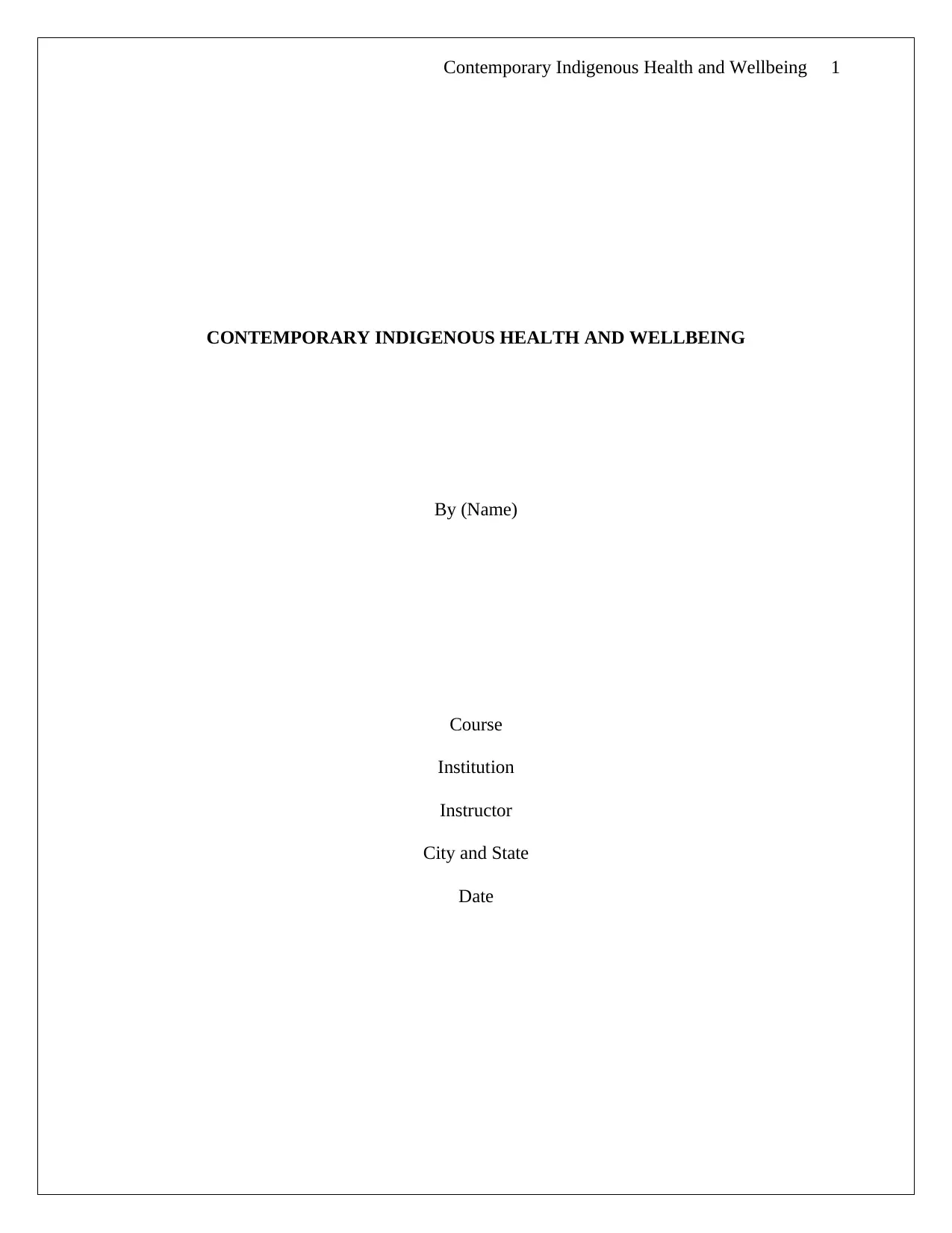
Contemporary Indigenous Health and Wellbeing 1
CONTEMPORARY INDIGENOUS HEALTH AND WELLBEING
By (Name)
Course
Institution
Instructor
City and State
Date
CONTEMPORARY INDIGENOUS HEALTH AND WELLBEING
By (Name)
Course
Institution
Instructor
City and State
Date
Paraphrase This Document
Need a fresh take? Get an instant paraphrase of this document with our AI Paraphraser
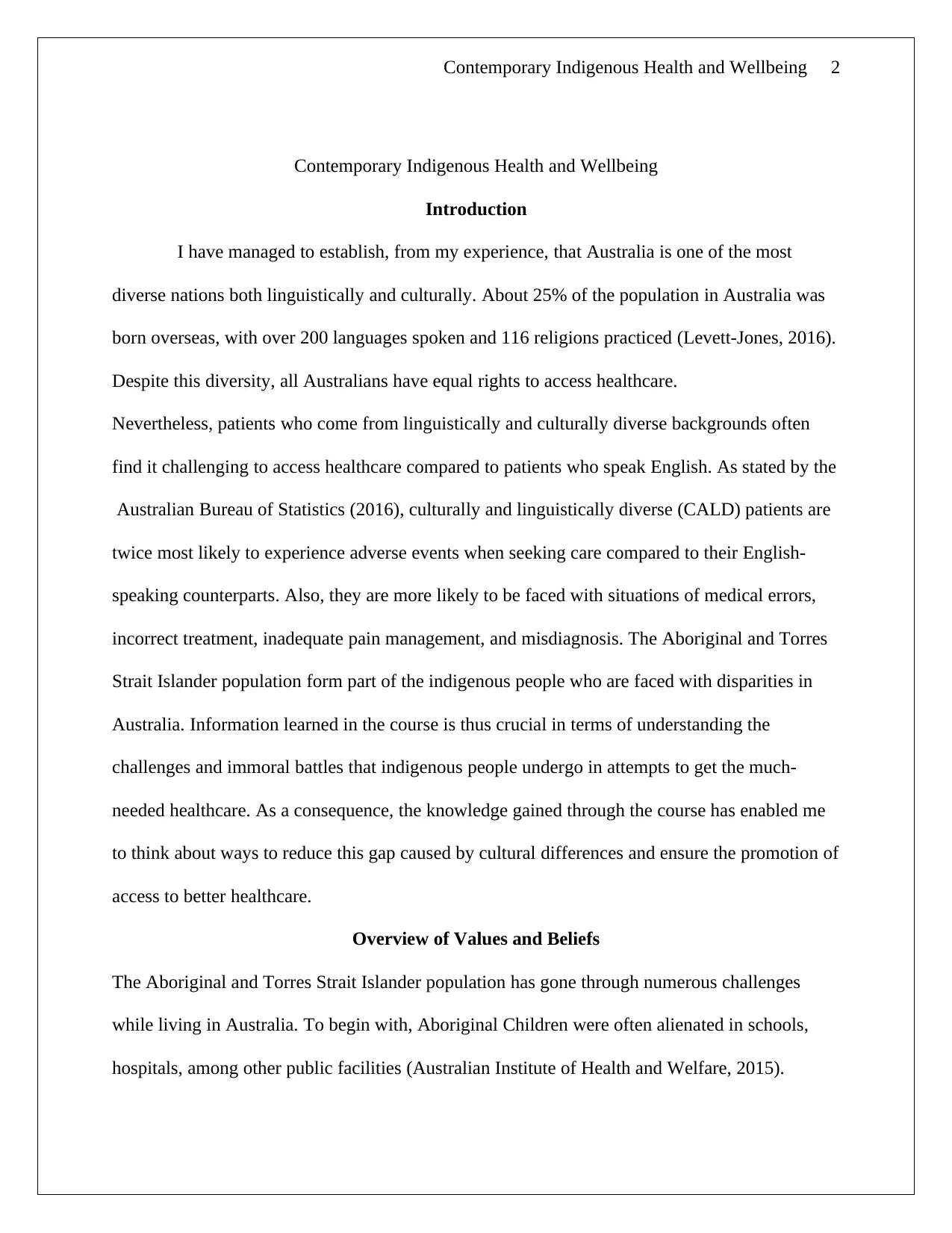
Contemporary Indigenous Health and Wellbeing 2
Contemporary Indigenous Health and Wellbeing
Introduction
I have managed to establish, from my experience, that Australia is one of the most
diverse nations both linguistically and culturally. About 25% of the population in Australia was
born overseas, with over 200 languages spoken and 116 religions practiced (Levett-Jones, 2016).
Despite this diversity, all Australians have equal rights to access healthcare.
Nevertheless, patients who come from linguistically and culturally diverse backgrounds often
find it challenging to access healthcare compared to patients who speak English. As stated by the
Australian Bureau of Statistics (2016), culturally and linguistically diverse (CALD) patients are
twice most likely to experience adverse events when seeking care compared to their English-
speaking counterparts. Also, they are more likely to be faced with situations of medical errors,
incorrect treatment, inadequate pain management, and misdiagnosis. The Aboriginal and Torres
Strait Islander population form part of the indigenous people who are faced with disparities in
Australia. Information learned in the course is thus crucial in terms of understanding the
challenges and immoral battles that indigenous people undergo in attempts to get the much-
needed healthcare. As a consequence, the knowledge gained through the course has enabled me
to think about ways to reduce this gap caused by cultural differences and ensure the promotion of
access to better healthcare.
Overview of Values and Beliefs
The Aboriginal and Torres Strait Islander population has gone through numerous challenges
while living in Australia. To begin with, Aboriginal Children were often alienated in schools,
hospitals, among other public facilities (Australian Institute of Health and Welfare, 2015).
Contemporary Indigenous Health and Wellbeing
Introduction
I have managed to establish, from my experience, that Australia is one of the most
diverse nations both linguistically and culturally. About 25% of the population in Australia was
born overseas, with over 200 languages spoken and 116 religions practiced (Levett-Jones, 2016).
Despite this diversity, all Australians have equal rights to access healthcare.
Nevertheless, patients who come from linguistically and culturally diverse backgrounds often
find it challenging to access healthcare compared to patients who speak English. As stated by the
Australian Bureau of Statistics (2016), culturally and linguistically diverse (CALD) patients are
twice most likely to experience adverse events when seeking care compared to their English-
speaking counterparts. Also, they are more likely to be faced with situations of medical errors,
incorrect treatment, inadequate pain management, and misdiagnosis. The Aboriginal and Torres
Strait Islander population form part of the indigenous people who are faced with disparities in
Australia. Information learned in the course is thus crucial in terms of understanding the
challenges and immoral battles that indigenous people undergo in attempts to get the much-
needed healthcare. As a consequence, the knowledge gained through the course has enabled me
to think about ways to reduce this gap caused by cultural differences and ensure the promotion of
access to better healthcare.
Overview of Values and Beliefs
The Aboriginal and Torres Strait Islander population has gone through numerous challenges
while living in Australia. To begin with, Aboriginal Children were often alienated in schools,
hospitals, among other public facilities (Australian Institute of Health and Welfare, 2015).
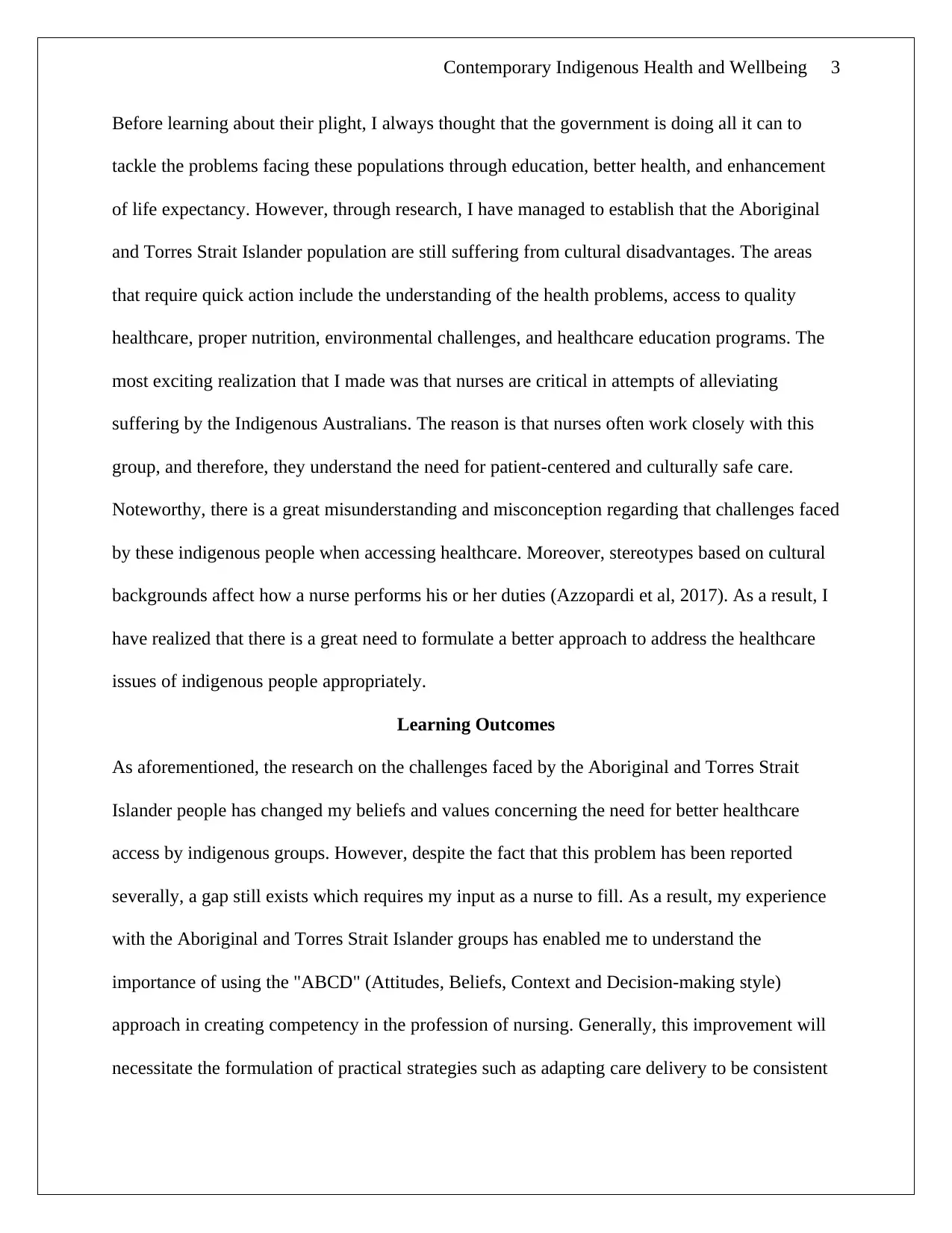
Contemporary Indigenous Health and Wellbeing 3
Before learning about their plight, I always thought that the government is doing all it can to
tackle the problems facing these populations through education, better health, and enhancement
of life expectancy. However, through research, I have managed to establish that the Aboriginal
and Torres Strait Islander population are still suffering from cultural disadvantages. The areas
that require quick action include the understanding of the health problems, access to quality
healthcare, proper nutrition, environmental challenges, and healthcare education programs. The
most exciting realization that I made was that nurses are critical in attempts of alleviating
suffering by the Indigenous Australians. The reason is that nurses often work closely with this
group, and therefore, they understand the need for patient-centered and culturally safe care.
Noteworthy, there is a great misunderstanding and misconception regarding that challenges faced
by these indigenous people when accessing healthcare. Moreover, stereotypes based on cultural
backgrounds affect how a nurse performs his or her duties (Azzopardi et al, 2017). As a result, I
have realized that there is a great need to formulate a better approach to address the healthcare
issues of indigenous people appropriately.
Learning Outcomes
As aforementioned, the research on the challenges faced by the Aboriginal and Torres Strait
Islander people has changed my beliefs and values concerning the need for better healthcare
access by indigenous groups. However, despite the fact that this problem has been reported
severally, a gap still exists which requires my input as a nurse to fill. As a result, my experience
with the Aboriginal and Torres Strait Islander groups has enabled me to understand the
importance of using the "ABCD" (Attitudes, Beliefs, Context and Decision-making style)
approach in creating competency in the profession of nursing. Generally, this improvement will
necessitate the formulation of practical strategies such as adapting care delivery to be consistent
Before learning about their plight, I always thought that the government is doing all it can to
tackle the problems facing these populations through education, better health, and enhancement
of life expectancy. However, through research, I have managed to establish that the Aboriginal
and Torres Strait Islander population are still suffering from cultural disadvantages. The areas
that require quick action include the understanding of the health problems, access to quality
healthcare, proper nutrition, environmental challenges, and healthcare education programs. The
most exciting realization that I made was that nurses are critical in attempts of alleviating
suffering by the Indigenous Australians. The reason is that nurses often work closely with this
group, and therefore, they understand the need for patient-centered and culturally safe care.
Noteworthy, there is a great misunderstanding and misconception regarding that challenges faced
by these indigenous people when accessing healthcare. Moreover, stereotypes based on cultural
backgrounds affect how a nurse performs his or her duties (Azzopardi et al, 2017). As a result, I
have realized that there is a great need to formulate a better approach to address the healthcare
issues of indigenous people appropriately.
Learning Outcomes
As aforementioned, the research on the challenges faced by the Aboriginal and Torres Strait
Islander people has changed my beliefs and values concerning the need for better healthcare
access by indigenous groups. However, despite the fact that this problem has been reported
severally, a gap still exists which requires my input as a nurse to fill. As a result, my experience
with the Aboriginal and Torres Strait Islander groups has enabled me to understand the
importance of using the "ABCD" (Attitudes, Beliefs, Context and Decision-making style)
approach in creating competency in the profession of nursing. Generally, this improvement will
necessitate the formulation of practical strategies such as adapting care delivery to be consistent
⊘ This is a preview!⊘
Do you want full access?
Subscribe today to unlock all pages.

Trusted by 1+ million students worldwide
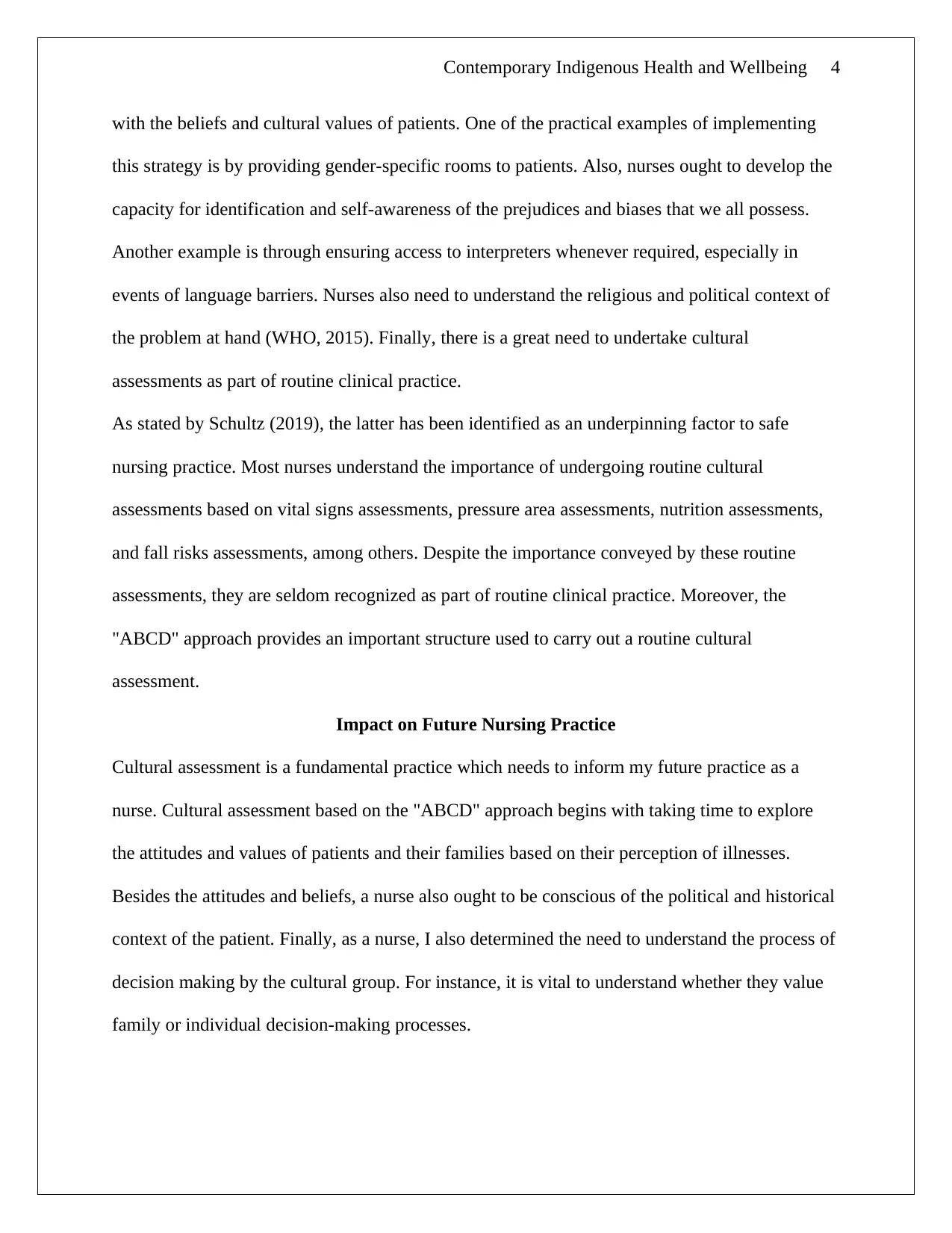
Contemporary Indigenous Health and Wellbeing 4
with the beliefs and cultural values of patients. One of the practical examples of implementing
this strategy is by providing gender-specific rooms to patients. Also, nurses ought to develop the
capacity for identification and self-awareness of the prejudices and biases that we all possess.
Another example is through ensuring access to interpreters whenever required, especially in
events of language barriers. Nurses also need to understand the religious and political context of
the problem at hand (WHO, 2015). Finally, there is a great need to undertake cultural
assessments as part of routine clinical practice.
As stated by Schultz (2019), the latter has been identified as an underpinning factor to safe
nursing practice. Most nurses understand the importance of undergoing routine cultural
assessments based on vital signs assessments, pressure area assessments, nutrition assessments,
and fall risks assessments, among others. Despite the importance conveyed by these routine
assessments, they are seldom recognized as part of routine clinical practice. Moreover, the
"ABCD" approach provides an important structure used to carry out a routine cultural
assessment.
Impact on Future Nursing Practice
Cultural assessment is a fundamental practice which needs to inform my future practice as a
nurse. Cultural assessment based on the "ABCD" approach begins with taking time to explore
the attitudes and values of patients and their families based on their perception of illnesses.
Besides the attitudes and beliefs, a nurse also ought to be conscious of the political and historical
context of the patient. Finally, as a nurse, I also determined the need to understand the process of
decision making by the cultural group. For instance, it is vital to understand whether they value
family or individual decision-making processes.
with the beliefs and cultural values of patients. One of the practical examples of implementing
this strategy is by providing gender-specific rooms to patients. Also, nurses ought to develop the
capacity for identification and self-awareness of the prejudices and biases that we all possess.
Another example is through ensuring access to interpreters whenever required, especially in
events of language barriers. Nurses also need to understand the religious and political context of
the problem at hand (WHO, 2015). Finally, there is a great need to undertake cultural
assessments as part of routine clinical practice.
As stated by Schultz (2019), the latter has been identified as an underpinning factor to safe
nursing practice. Most nurses understand the importance of undergoing routine cultural
assessments based on vital signs assessments, pressure area assessments, nutrition assessments,
and fall risks assessments, among others. Despite the importance conveyed by these routine
assessments, they are seldom recognized as part of routine clinical practice. Moreover, the
"ABCD" approach provides an important structure used to carry out a routine cultural
assessment.
Impact on Future Nursing Practice
Cultural assessment is a fundamental practice which needs to inform my future practice as a
nurse. Cultural assessment based on the "ABCD" approach begins with taking time to explore
the attitudes and values of patients and their families based on their perception of illnesses.
Besides the attitudes and beliefs, a nurse also ought to be conscious of the political and historical
context of the patient. Finally, as a nurse, I also determined the need to understand the process of
decision making by the cultural group. For instance, it is vital to understand whether they value
family or individual decision-making processes.
Paraphrase This Document
Need a fresh take? Get an instant paraphrase of this document with our AI Paraphraser
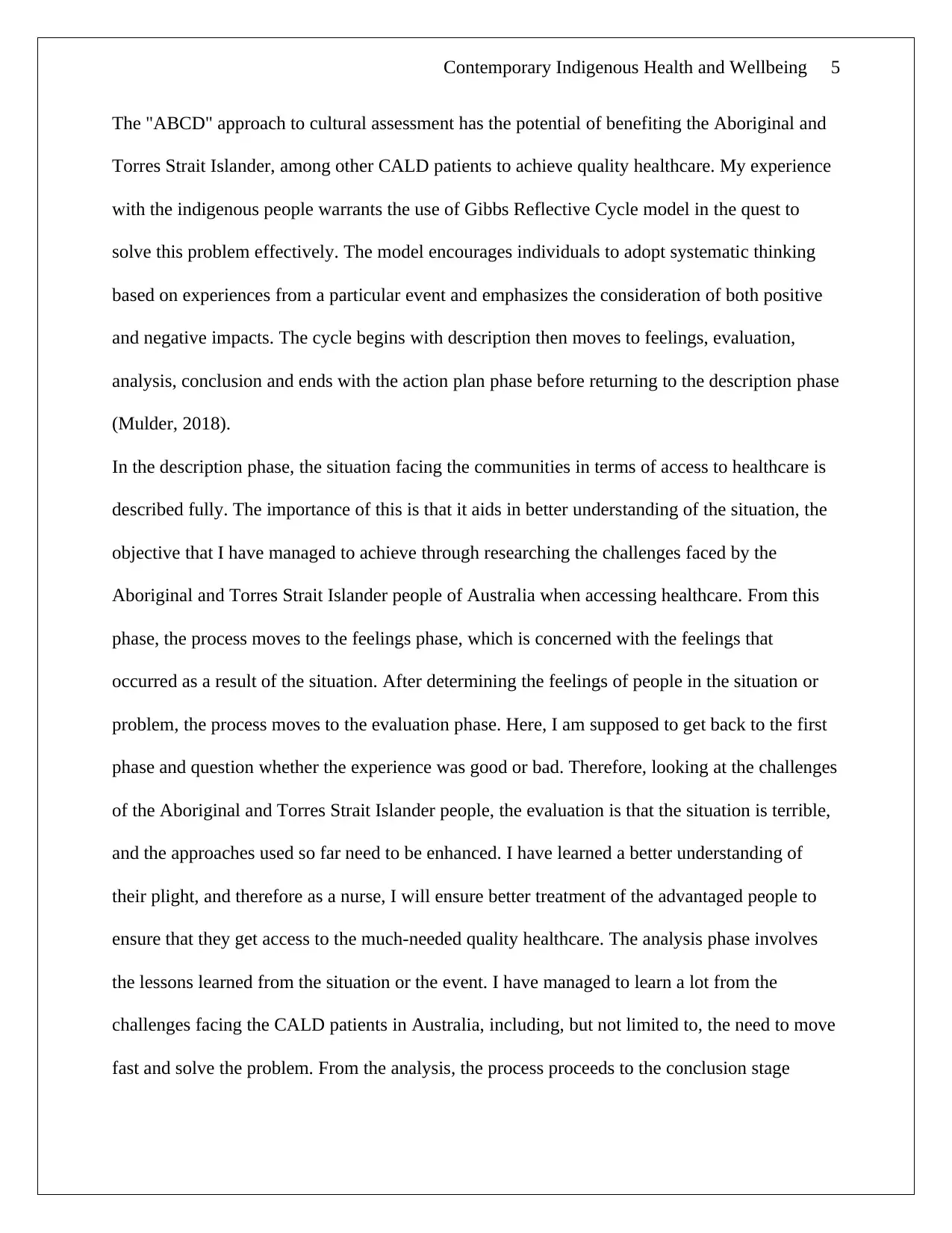
Contemporary Indigenous Health and Wellbeing 5
The "ABCD" approach to cultural assessment has the potential of benefiting the Aboriginal and
Torres Strait Islander, among other CALD patients to achieve quality healthcare. My experience
with the indigenous people warrants the use of Gibbs Reflective Cycle model in the quest to
solve this problem effectively. The model encourages individuals to adopt systematic thinking
based on experiences from a particular event and emphasizes the consideration of both positive
and negative impacts. The cycle begins with description then moves to feelings, evaluation,
analysis, conclusion and ends with the action plan phase before returning to the description phase
(Mulder, 2018).
In the description phase, the situation facing the communities in terms of access to healthcare is
described fully. The importance of this is that it aids in better understanding of the situation, the
objective that I have managed to achieve through researching the challenges faced by the
Aboriginal and Torres Strait Islander people of Australia when accessing healthcare. From this
phase, the process moves to the feelings phase, which is concerned with the feelings that
occurred as a result of the situation. After determining the feelings of people in the situation or
problem, the process moves to the evaluation phase. Here, I am supposed to get back to the first
phase and question whether the experience was good or bad. Therefore, looking at the challenges
of the Aboriginal and Torres Strait Islander people, the evaluation is that the situation is terrible,
and the approaches used so far need to be enhanced. I have learned a better understanding of
their plight, and therefore as a nurse, I will ensure better treatment of the advantaged people to
ensure that they get access to the much-needed quality healthcare. The analysis phase involves
the lessons learned from the situation or the event. I have managed to learn a lot from the
challenges facing the CALD patients in Australia, including, but not limited to, the need to move
fast and solve the problem. From the analysis, the process proceeds to the conclusion stage
The "ABCD" approach to cultural assessment has the potential of benefiting the Aboriginal and
Torres Strait Islander, among other CALD patients to achieve quality healthcare. My experience
with the indigenous people warrants the use of Gibbs Reflective Cycle model in the quest to
solve this problem effectively. The model encourages individuals to adopt systematic thinking
based on experiences from a particular event and emphasizes the consideration of both positive
and negative impacts. The cycle begins with description then moves to feelings, evaluation,
analysis, conclusion and ends with the action plan phase before returning to the description phase
(Mulder, 2018).
In the description phase, the situation facing the communities in terms of access to healthcare is
described fully. The importance of this is that it aids in better understanding of the situation, the
objective that I have managed to achieve through researching the challenges faced by the
Aboriginal and Torres Strait Islander people of Australia when accessing healthcare. From this
phase, the process moves to the feelings phase, which is concerned with the feelings that
occurred as a result of the situation. After determining the feelings of people in the situation or
problem, the process moves to the evaluation phase. Here, I am supposed to get back to the first
phase and question whether the experience was good or bad. Therefore, looking at the challenges
of the Aboriginal and Torres Strait Islander people, the evaluation is that the situation is terrible,
and the approaches used so far need to be enhanced. I have learned a better understanding of
their plight, and therefore as a nurse, I will ensure better treatment of the advantaged people to
ensure that they get access to the much-needed quality healthcare. The analysis phase involves
the lessons learned from the situation or the event. I have managed to learn a lot from the
challenges facing the CALD patients in Australia, including, but not limited to, the need to move
fast and solve the problem. From the analysis, the process proceeds to the conclusion stage
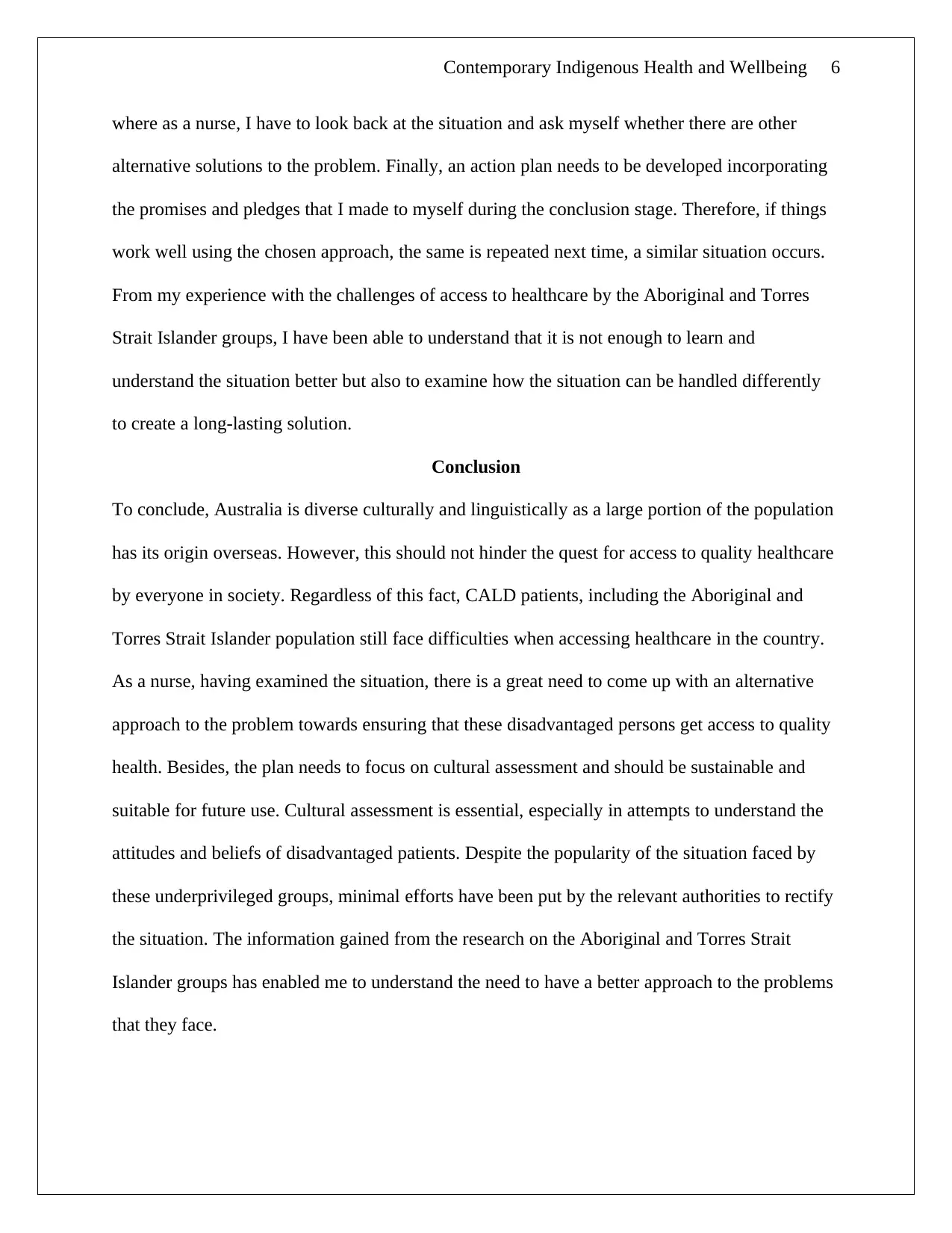
Contemporary Indigenous Health and Wellbeing 6
where as a nurse, I have to look back at the situation and ask myself whether there are other
alternative solutions to the problem. Finally, an action plan needs to be developed incorporating
the promises and pledges that I made to myself during the conclusion stage. Therefore, if things
work well using the chosen approach, the same is repeated next time, a similar situation occurs.
From my experience with the challenges of access to healthcare by the Aboriginal and Torres
Strait Islander groups, I have been able to understand that it is not enough to learn and
understand the situation better but also to examine how the situation can be handled differently
to create a long-lasting solution.
Conclusion
To conclude, Australia is diverse culturally and linguistically as a large portion of the population
has its origin overseas. However, this should not hinder the quest for access to quality healthcare
by everyone in society. Regardless of this fact, CALD patients, including the Aboriginal and
Torres Strait Islander population still face difficulties when accessing healthcare in the country.
As a nurse, having examined the situation, there is a great need to come up with an alternative
approach to the problem towards ensuring that these disadvantaged persons get access to quality
health. Besides, the plan needs to focus on cultural assessment and should be sustainable and
suitable for future use. Cultural assessment is essential, especially in attempts to understand the
attitudes and beliefs of disadvantaged patients. Despite the popularity of the situation faced by
these underprivileged groups, minimal efforts have been put by the relevant authorities to rectify
the situation. The information gained from the research on the Aboriginal and Torres Strait
Islander groups has enabled me to understand the need to have a better approach to the problems
that they face.
where as a nurse, I have to look back at the situation and ask myself whether there are other
alternative solutions to the problem. Finally, an action plan needs to be developed incorporating
the promises and pledges that I made to myself during the conclusion stage. Therefore, if things
work well using the chosen approach, the same is repeated next time, a similar situation occurs.
From my experience with the challenges of access to healthcare by the Aboriginal and Torres
Strait Islander groups, I have been able to understand that it is not enough to learn and
understand the situation better but also to examine how the situation can be handled differently
to create a long-lasting solution.
Conclusion
To conclude, Australia is diverse culturally and linguistically as a large portion of the population
has its origin overseas. However, this should not hinder the quest for access to quality healthcare
by everyone in society. Regardless of this fact, CALD patients, including the Aboriginal and
Torres Strait Islander population still face difficulties when accessing healthcare in the country.
As a nurse, having examined the situation, there is a great need to come up with an alternative
approach to the problem towards ensuring that these disadvantaged persons get access to quality
health. Besides, the plan needs to focus on cultural assessment and should be sustainable and
suitable for future use. Cultural assessment is essential, especially in attempts to understand the
attitudes and beliefs of disadvantaged patients. Despite the popularity of the situation faced by
these underprivileged groups, minimal efforts have been put by the relevant authorities to rectify
the situation. The information gained from the research on the Aboriginal and Torres Strait
Islander groups has enabled me to understand the need to have a better approach to the problems
that they face.
⊘ This is a preview!⊘
Do you want full access?
Subscribe today to unlock all pages.

Trusted by 1+ million students worldwide
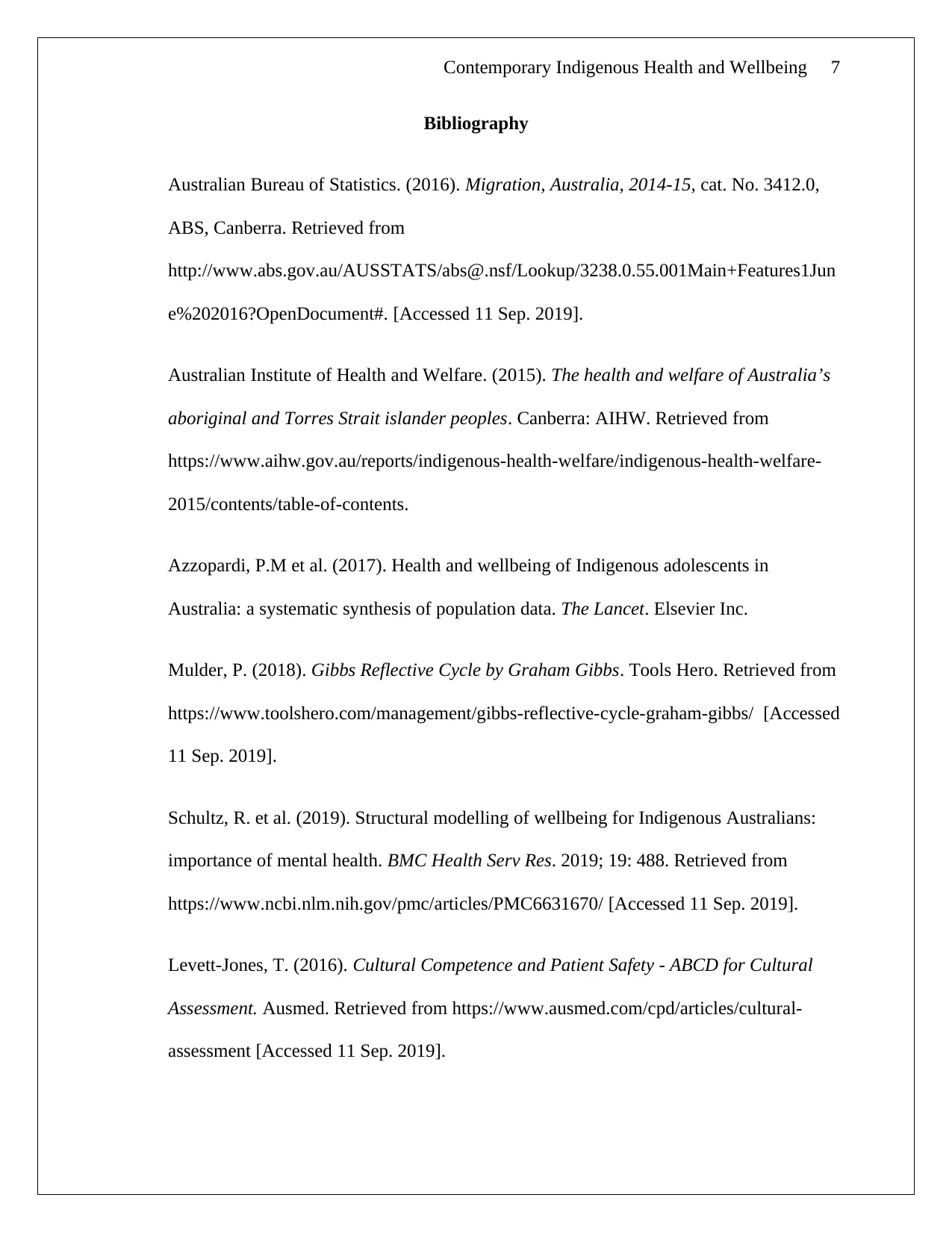
Contemporary Indigenous Health and Wellbeing 7
Bibliography
Australian Bureau of Statistics. (2016). Migration, Australia, 2014-15, cat. No. 3412.0,
ABS, Canberra. Retrieved from
http://www.abs.gov.au/AUSSTATS/abs@.nsf/Lookup/3238.0.55.001Main+Features1Jun
e%202016?OpenDocument#. [Accessed 11 Sep. 2019].
Australian Institute of Health and Welfare. (2015). The health and welfare of Australia’s
aboriginal and Torres Strait islander peoples. Canberra: AIHW. Retrieved from
https://www.aihw.gov.au/reports/indigenous-health-welfare/indigenous-health-welfare-
2015/contents/table-of-contents.
Azzopardi, P.M et al. (2017). Health and wellbeing of Indigenous adolescents in
Australia: a systematic synthesis of population data. The Lancet. Elsevier Inc.
Mulder, P. (2018). Gibbs Reflective Cycle by Graham Gibbs. Tools Hero. Retrieved from
https://www.toolshero.com/management/gibbs-reflective-cycle-graham-gibbs/ [Accessed
11 Sep. 2019].
Schultz, R. et al. (2019). Structural modelling of wellbeing for Indigenous Australians:
importance of mental health. BMC Health Serv Res. 2019; 19: 488. Retrieved from
https://www.ncbi.nlm.nih.gov/pmc/articles/PMC6631670/ [Accessed 11 Sep. 2019].
Levett-Jones, T. (2016). Cultural Competence and Patient Safety - ABCD for Cultural
Assessment. Ausmed. Retrieved from https://www.ausmed.com/cpd/articles/cultural-
assessment [Accessed 11 Sep. 2019].
Bibliography
Australian Bureau of Statistics. (2016). Migration, Australia, 2014-15, cat. No. 3412.0,
ABS, Canberra. Retrieved from
http://www.abs.gov.au/AUSSTATS/abs@.nsf/Lookup/3238.0.55.001Main+Features1Jun
e%202016?OpenDocument#. [Accessed 11 Sep. 2019].
Australian Institute of Health and Welfare. (2015). The health and welfare of Australia’s
aboriginal and Torres Strait islander peoples. Canberra: AIHW. Retrieved from
https://www.aihw.gov.au/reports/indigenous-health-welfare/indigenous-health-welfare-
2015/contents/table-of-contents.
Azzopardi, P.M et al. (2017). Health and wellbeing of Indigenous adolescents in
Australia: a systematic synthesis of population data. The Lancet. Elsevier Inc.
Mulder, P. (2018). Gibbs Reflective Cycle by Graham Gibbs. Tools Hero. Retrieved from
https://www.toolshero.com/management/gibbs-reflective-cycle-graham-gibbs/ [Accessed
11 Sep. 2019].
Schultz, R. et al. (2019). Structural modelling of wellbeing for Indigenous Australians:
importance of mental health. BMC Health Serv Res. 2019; 19: 488. Retrieved from
https://www.ncbi.nlm.nih.gov/pmc/articles/PMC6631670/ [Accessed 11 Sep. 2019].
Levett-Jones, T. (2016). Cultural Competence and Patient Safety - ABCD for Cultural
Assessment. Ausmed. Retrieved from https://www.ausmed.com/cpd/articles/cultural-
assessment [Accessed 11 Sep. 2019].
Paraphrase This Document
Need a fresh take? Get an instant paraphrase of this document with our AI Paraphraser
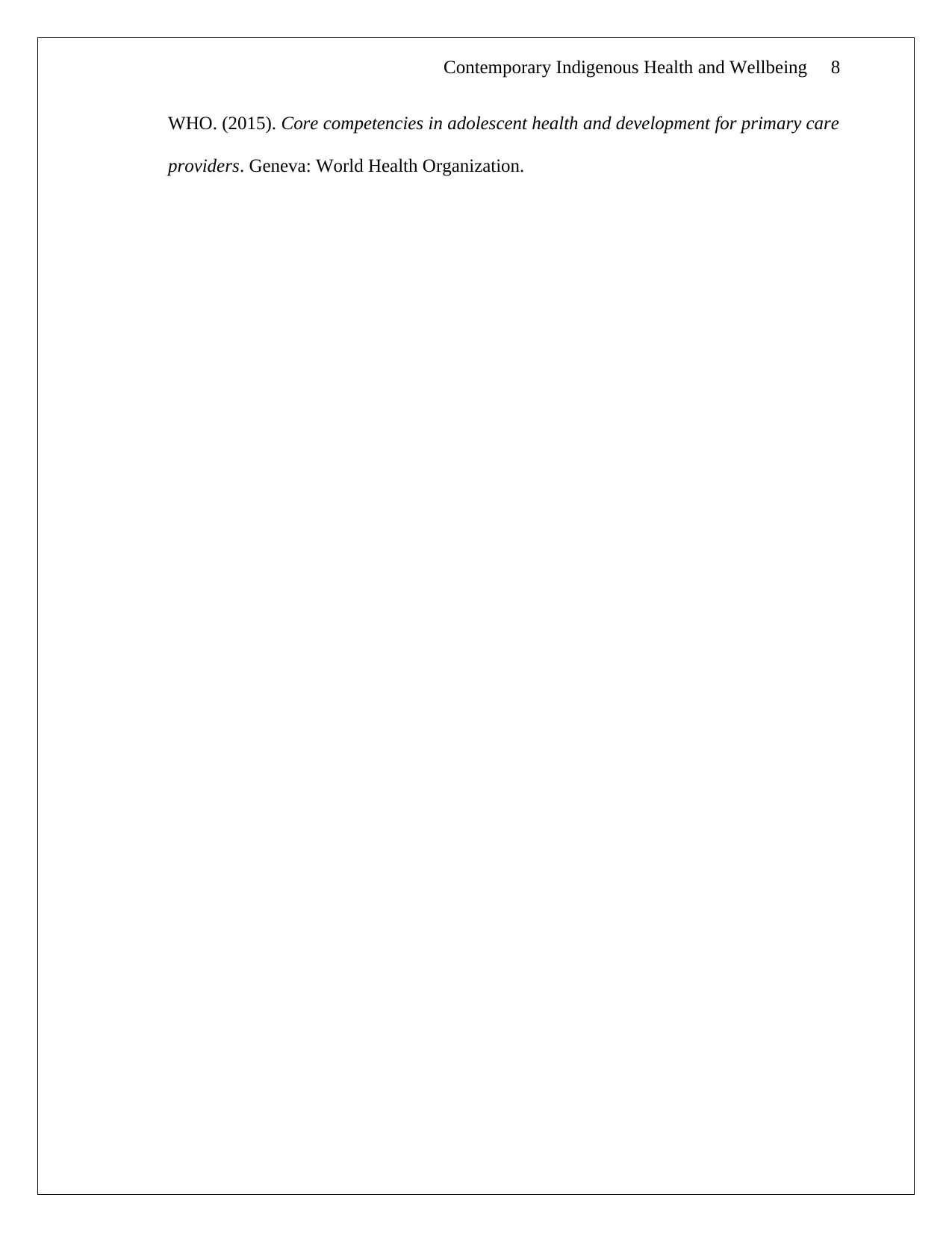
Contemporary Indigenous Health and Wellbeing 8
WHO. (2015). Core competencies in adolescent health and development for primary care
providers. Geneva: World Health Organization.
WHO. (2015). Core competencies in adolescent health and development for primary care
providers. Geneva: World Health Organization.
1 out of 8
Related Documents
Your All-in-One AI-Powered Toolkit for Academic Success.
+13062052269
info@desklib.com
Available 24*7 on WhatsApp / Email
![[object Object]](/_next/static/media/star-bottom.7253800d.svg)
Unlock your academic potential
Copyright © 2020–2025 A2Z Services. All Rights Reserved. Developed and managed by ZUCOL.





